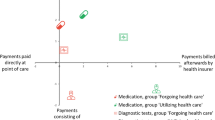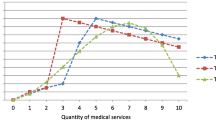Abstract
Efficient contracting of health care requires effective consumer channeling. Little is known about the effectiveness of channeling strategies. We study channeling incentives on pharmacy choice using a large scale discrete choice experiment. Financial incentives prove to be effective. Positive financial incentives are less effective than negative financial incentives. Channeling through qualitative incentives also leads to a significant impact on provider choice. While incentives help to channel, a strong status quo bias needs to be overcome before consumers change pharmacies. Focusing on consumers who are forced to choose a new pharmacy seems to be the most effective strategy.
Similar content being viewed by others
References
Bech M., Gyrd-Hansen D. (2005) Effects coding in discrete choice experiments. Health Economics 14(10): 1079–1083. doi:10.1002/hec.984
Boonen L.H.H.M., Schut F.T. (2007) Effect van prikkels op keuze voor zorgaanbieders. Economisch-Statistische Berichten 92(4521): 651–653
Boonen L.H.H.M., Schut F.T., Koolman X. (2008) Consumer channeling by health insurers: natural experiments with preferred providers in the Dutch pharmacy market. Health Economics 17(3): 299–316. doi:10.1002/hec.1265
Chu-Weininger, M. Y. L., & Balkrishnan, R. (2006). Consumer satisfaction with primary care provider choice and associated trust. BMC Health Services Research, 6, 139.
Enthoven A.C., van de Ven W.P.M.M. (2007) Going Dutch - managed competition health insurance in the Netherlands. The New England Journal of Medicine 357(24): 2421–2423. doi:10.1056/NEJMp078199
Feldman R., Finch M., Dowd B., Cassou S. (1989) The demand for employment-based health insurance plans. The Journal of Human Resources 24(1): 115–142. doi:10.2307/145935
Garnick D.W., Lichtenberg E., Phibbs C.S., Luft H.S., Peltzman D.J., McPhee S.J. (1989) The sensitivity of conditional choice models for hospital care to estimation technique. Journal of Health Economics 8(4): 377–397. doi:10.1016/0167-6296(90)90022-U
Gawande A.A., Blendon R., Brodie M., Benson J.M., Levitt L., Hugick L. (1998) Does dissatisfaction with health plans stem from having no choices?. Health Affairs (Project Hope) 17(5): 184–194. doi:10.1377/hlthaff.17.5.184
Hanemann W. (1983) Marginal welfare measures for discrete choice models. Economics Letters 13: 129–136. doi:10.1016/0165-1765(83)90074-5
Hole A.R. (2007) A comparison of approaches to estimating confidence intervals for willingness to pay measures. Health Economics 16(8): 827–840. doi:10.1002/hec.1197
Hole A.R. (2008) Modeling heterogeneity in patients’ preferences for the attributes of a general practitioner appointment. Journal of Health Economics 27(4): 1078–1094. doi:10.1016/j.jhealeco.2007.11.006
Huber J., Zwerina K. (1996) The importance of utility balance in efficient choice designs. JMR, Journal of Marketing Research 33(3): 107. doi:10.2307/3152127
Huber, P. J. (1967). The behavior of maximum likelihood estimates under non-standard conditions. In Proceedings of the fifth Berkeley symposium on mathematical statistics and probability. Berkeley, CA: University of California Press, 1: 221–233.
Kahneman D., Knetsch J.L., Thaler R.H. (1991) The endowment effect, loss aversion and status quo bias. The Journal of Economic Perspectives 5(1): 193–206
Kim B.R. (1990) A logit analysis of hospital choice behavior in Chollabukdo Province of Korea. Social Science & Medicine 30(10): 1119–1129. doi:10.1016/0277-9536(90)90298-7
King M.T., Hall J., Lancsar E., Fiebig D., Hossain I., Louviere J. et al (2007) Patient preferences for managing asthma: Results from a discrete choice experiment. Health Economics 16(7): 703–717. doi:10.1002/hec.1193
Kjaer T., Bech M., Gyrd-Hansen D., Hart-Hansen K. (2006) Ordering effect and price sensitivity in discrete choice experiments: Need we worry?. Health Economics 15(11): 1217–1228. doi:10.1002/hec.1117
Lancaster K. (1966) A new approach to consumer theory. The Journal of Political Economy 74(2): 132–157. doi:10.1086/259131
Lancaster K. (1971) Consumer demand a new approach. Columbia University Press, Columbia
Lancsar, E. (2002). Deriving welfare measures from stated preference discrete choice modelling experiments (pp. 1–53). Sydney: Centre for Health economics research and evaluation, University of Technology Sydney.
Longo M.F., Cohen D.R., Hood K., Edwards A., Robling M., Elwyn G. et al (2006) Involving patients in primary care consultations: Assessing preferences using discrete choice experiments. The British Journal of General Practice 56(522): 35–42
Manski C.F. (1977) The structure of random utility models. Theory and Decision, 8: 229–254. doi:10.1007/BF00133443
McFadden D. (1974) Conditional logit analysis of qualitative choice behavior. In: Zarembka P. (eds) Frontiers in econometrics. Academic Press, New York
McIntosh E., Ryan M. (2002) Using discrete choice experiments to derive welfare estimates for the provision of elective surgery: Implications of discontinuous preferences. Journal of Economic Psychology 23(3): 367–382. doi:10.1016/S0167-4870(02)00081-8
Melnick G.A., Zwanziger J., Bamezai A., Pattison R. (1992) The effects of market structure and bargaining position on hospital prices. Journal of Health Economics 11(3): 217–233. doi:10.1016/0167-6296(92)90001-H
Miller N.H. (2006) Insurer-provider integration, credible commitment, and managed-care backlash. Journal of Health Economics 25(5): 861–876. doi:10.1016/j.jhealeco.2005.12.007
Neipp J., Zeckhauser R. (1985) Persistence in the choice of health plans. Advances in Health Economics and Health Services Research 6: 47–72
NZa. (2007). Visiedocument Richting geven aan keuzes. Kunnen verzekeraars consumenten stimuleren naar gecontracteerde voorkeursaanbieders te gaan? De Nederlandse Zorgautoriteit: Utrecht.
Pauly M.V. (1987) Monopsony power in health insurance: Thinking straight while standing on your head. Journal of Health Economics 6(1): 73–81. doi:10.1016/0167-6296(87)90032-4
Phillips K.A., Maddala T., Johnson F.R. (2002) Measuring preferences for health care interventions using conjoint analysis: An application to HIV testing. Health Services Research 37(6): 1681–1705. doi:10.1111/1475-6773.01115
Rubin G., Bate A., George A., Shackley P., Hall N. (2006) Preferences for access to the GP: A discrete choice experiment. The British Journal of General Practice 56: 743–748
Ryan M., Netten A., Skatun D., Smith P. (2006) Using discrete choice experiments to estimate a preference-based measure of outcome—an application to social care for older people. Journal of Health Economics 25(5): 927–944. doi:10.1016/j.jhealeco.2006.01.001
Samuelson W., Zeckhauser R. (1988) Status quo bias in decision making. Journal of Risk and Uncertainty 1: 7–59. doi:10.1007/BF00055564
Schut F.T., Brouwer W.B.F. (2004) Preferente Apotheker?. Jazeker! Economisch-Statistische Berichten 89(4435): 266–269
Scott A., Watson M.S., Ross S. (2003) Eliciting preferences of the community for out of hours care provided by general practitioners: A stated preference discrete choice experiment Social Science & Medicine, 56(4): 803–14
Sorensen A.T. (2003) Insurer-hospital bargaining: Negotiated discounts in post-deregulation Connecticut. The Journal of Industrial Economics 51(4): 469–490. doi:10.1111/j.0022-1821.2003.00211.x
Stata Press. 1999. Stata User’s Guide Release 6 (pp. 256–260). Texas: Stata Press.
Staten M., Dunkelberg W., Umbeck J. (1987) Market share and the illusion of power. Can Blue Cross force hospitals to discount?. Journal of Health Economics 6(1): 43–58. doi:10.1016/0167-6296(87)90030-0
Strombom B.A., Buchmueller T.C., Feldstein P.J. (2002) Switching costs, price sensitivity and health plan choice. Journal of Health Economics 21(1): 89–116. doi:10.1016/S0167-6296(01)00124-2
Tai W.T., Porell F.W., Adams E.K. (2004) Hospital choice of rural Medicare beneficiaries: Patient, hospital attributes, and the patient-physician relationship. Health Services Research 39(6): 1903–1922. doi:10.1111/j.1475-6773.2004.00324.x
Tversky A., Kahneman D. (1991) Loss aversion in riskless choice: A reference-dependent model. the Quarterly Journal of Economics 106(4): 1039–1061
Vick S., Scott A. (1998) Agency in health care. Examining patients’ preferences for attributes of the doctor-patient relationship. Journal of Health Economics 17(5): 587–605. doi:10.1016/S0167-6296(97)00035-0
White H. (1980) A heteroskedasticity-consistent covariance matrix estimator and a direct test for heteroskedasticity. Econometrica, 28: 817–830. doi:10.2307/1912934
White H. (1982) Maximum likelihood estimation of misspecified models. Econometrica 50: 1–25. doi:10.2307/1912526
Wolf de P., Brouwer W.B.F., Rutten F.H. (2005) Regulating the Dutch pharmaceutical market: Improving efficiency or controlling costs?. The International Journal of Health Planning and Management, 20(4): 351–374. doi:10.1002/hpm.819
Author information
Authors and Affiliations
Corresponding author
Rights and permissions
About this article
Cite this article
Boonen, L.H.H.M., Schut, F.T., Donkers, B. et al. Which preferred providers are really preferred? Effectiveness of insurers’ channeling incentives on pharmacy choice. Int J Health Care Finance Econ 9, 347–366 (2009). https://doi.org/10.1007/s10754-009-9055-5
Received:
Accepted:
Published:
Issue Date:
DOI: https://doi.org/10.1007/s10754-009-9055-5
Keywords
- Preferred provider choice
- Status quo bias
- Pharmacy market
- Willingness to pay
- Discrete choice experiments




